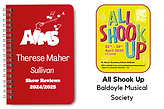UPCOMING EVENTS
LATEST NEWS
Our House as presented by LMVG
Leixlip Musical and Variety Group Our House – The Madness Musical Tuesday 29 th April 2025 It is to Leixlip Musical and Variety Group’s eternal credit that, year after year, they produce top quality, highly professional and innovative productions in a GAA hall which, let's face it, is not built for large scale theatrical productions. The seating, the queue for the ladies, the lack of comfort afforded in most theatre spaces around the country, matter not to those who are lucky enough to...
All Shook Up as presented by Baldoyle Musical Society
Society Name: Baldoyle Musical Society Show Name: All Shook Up Adjudicator Date of Attendance: 26.05.2025 Brief Overview of Show and Evaluation of Front of House Baldoyle Musical Society’s production of All Shook Up was a vibrant, well-paced, and energetically performed show that demonstrated a strong sense of fun, community, and musicality. Tackling a jukebox musical like this requires a careful blend of nostalgic charm, character commitment, and storytelling precision, and the company...
The Wedding Singer as presented by Dunboyne Musical Society
Dunboyne Musical Society The Wedding Singer Wednesday 23rd April 2025 ‘The Wedding Singer,’ an upbeat love story based on the 1998 movie of the same name, has been a very popular choice this season. With its hilarious book and catchy 80s style tunes that sound like familiar hits of yesteryear, what’s not to love? Dunboyne Musical Society took on this totally awesome show which parodies the excesses of the 1980s, with many side-splitting moments, lots of exhilarating choreography and nods...
EASTERN SOCIETIES
Below is our comprehensive list of EASTERN societies.
If you would like the contact details for a society, please contact either the Registrar or the National PRO. If you would like information distributed to our members for a small cost, please Contact our National Secretary.







